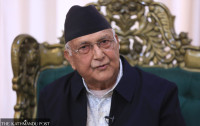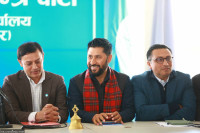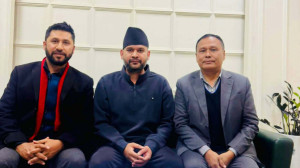Politics
Despite federalism and local elections, power still resides in the hands of a few
The political parties continue to function in a pyramid model where a handful of leaders at the top make decisions on behalf of a vast majority, analysts say..jpg&w=900&height=601)
Binod Ghimire
Three dozen lawmakers from the 110-member Province 3 Assembly did not want Hetauda as their provincial headquarters. These 36 members had argued that Hetauda should not be the capital since it was not accessible to people from the mountains.
However, the nine-member secretariat of the Nepal Communist Party (NCP) decided that the province would be named Bagmati and Hetauda, which was a temporary capital, will be its permanent headquarters. The NCP’s provincial Parliamentary Party accepted the secretariat’s decision and duly issued a whip to its members to follow. When a vote was held in the assembly on Sunday, not a single lawmaker from the party stood against the decision.
“When the party issues a whip you have two options, either follow or quit the party,” said Ranta Dhakal, an assembly member from the ruling party. “We chose to follow the whip despite knowing that it was against the expectations of the general public.”
During public consultations, a majority of people had said that Hetauda should not be the provincial capital, according to assembly members. But in contradiction to the popular will, the communist party leadership asked lawmakers to follow its decision without question.
Imposing decisions from the top without taking the opinions of elected representatives into account has long been the modus operandi of Nepal’s political parties, say political analysts. Federalism and local elections were supposed to ensure the people’s representation but, instead, the parties have stuck to their old ways of a few top leaders issuing diktats from on high.
From the very beginning—during the constitution-drafting process—the parties have ignored public opinion, say analysts.
The Constituent Assembly had formed a Citizen Relations and Public Opinion Collection Committee to gather feedback that would be incorporated into the constitution. Though the Constituent Assembly worked for over seven years to draft the statute, feedback was collected in around a week. The committee collected feedback, directly or indirectly through email and writing, from around 185,000 people. Suggestions were submitted to the assembly in July 2015, just two months before the statute was promulgated.
Pramila Rana, who chaired the committee, says that only those suggestions that “benefitted” the top leadership were taken and the rest discarded.
“The top party leaderships are only concerned with ruling the people,” Rana told the Post. “They didn’t care about the people’s aspiration then and they don’t now. It is saddening that party leaders who were established through the people’s movements have forgotten what they owe to the people.”
It is not just the current ruling party that is guilty of this; almost all of Nepal’s parties have organisational structures that are top-down, and they don’t find it necessary to discuss issues of vital importance with a wider audience. That’s why even four years after constitution promulgation, many are still questioning the process the parties followed to adopt it.
It took two constituent assemblies for the parties to agree on a draft of the constitution. When they decided to ‘fast-track’ the promulgation, the urgency was not because they wanted to deliver the statute on time but in order to serve the self-interest of a handful of leaders, analysts say.
“The people enjoy supreme authority, in principle, but in practice, they don’t have a say in anything,” said Rajendra Maharjan, a political analyst and columnist for Kantipur, the Post’s sister paper.
The Madhesi and Tharu leaders who objected to the constitution promulgation—they did not participate in the voting—are still demanding amendments but they’ve been sidelined by the ruling communist party, which has a comfortable majority in the federal parliament now.
Analysts say dialogue and citizen engagement are central to democracy, but despite the country adopting a new constitution and the federal system, parties have failed to internalise the importance of reaching out to the people.
Hari Roka, an analyst who closely follows leftist politics, said that political parties—be they the Nepal Communist Party or the Nepali Congress—have had a centralised mindset right from the time of constitution drafting.
“Identity and capability were two accepted principles for federating the states, but they were not followed while finalising the constitution,” said Roka. “It is evident that the top leadership was decisive during the constitution drafting process and now, even when the country has been federated, they are functioning with a centralised mindset.”
In a recent case, conflict victims were largely ignored when the government organised consultations in what it called an “effort to collect feedback” before amending the Enforced Disappearances Enquiry and Truth and Reconciliation Act-2014.
Victims, who were called to provide suggestions, were not given enough time to express their concerns and grievances, which will mean the decision will ultimately be made on the basis of what the top leadership of the political parties thinks is right, said victims. Nepal’s transitional justice process has dragged on for over a decade now, but the government has done little to amend the Act as per the 2015 Supreme Court ruling and international obligations. The international community and rights defenders have for long called for wider consultation with victims and other concerned parties. On Tuesday, Human Rights Watch, a New York-based rights group, in its World Report 2020 said that Nepal had failed to ensure justice to conflict victims.
The transitional justice process, which should have been a national priority, has also fallen victim to the whims of a handful of political leaders, and the ultimate casualty here is democracy, say analysts.
“In a true democracy, the decision-making process follows an inverted pyramid where the decision trickles down to the leaders from the people,” said Maharjan. “However, the Nepali leadership follow the reverse, where a few people make decisions that affect the entire country.”




 6.73°C Kathmandu
6.73°C Kathmandu















